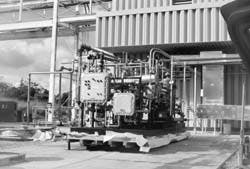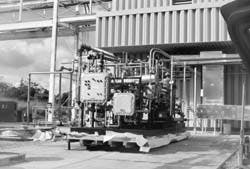DSM Deutchland GmbH, Dusseldorf, is installing a $1 million propylene recovery unit in a polypropylene plant under construction in Geleen, The Netherlands.
The system, designed by Membrane Technology & Research Inc. (MTR), Menlo Park, Calif., will recover propylene from plant vents and recycle it for polymerization. Nitrogen recovered by the process will be used to remove unreacted monomer from the polymer product.
Technip is constructing the DSM plant, which will use the Amoco/Chisso polypropylene process, according to MTR. MTR says DSM's VaporSep system will be the largest of its kind.
"We evaluated the available technologies for propylene recovery, including pressure swing adsorption, and found that the membrane-based VaporSep technology was more cost-effective than other alternatives," said Maurice Ivaldi, project director for Technip in Lyon, France. "We expect the...system to pay for itself in about a year, and to save DSM approximately $1 million in propylene and nitrogen each year thereafter."
Technip will fabricate, erect, and commission the system for DSM. Fabrication will begin in March or April. Commissioning of the unit is scheduled for November 1996.
DSM will use Membrane Technology & Research Inc.'s VaporSep process, shown here, to recover and recycle propylene monomer in its polypropylene plant, under construction in Geleen, The Netherlands.
Process description
The system separates and recycles the gases produced during resin degassing. In this process, polymer particles are purged with nitrogen to remove unreacted monomer and other volatile hydrocarbons.
The vented gas from the degassing process typically is flared, destroying both the unreacted monomer and the nitrogen used for degassing. In the propylene-recovery system, the gas mixture (about 10-25% monomer in nitrogen) is compressed, then sent to the membrane separation unit.
The membranes separate the mixture into two streams:
- A monomer-depleted stream (90-95% nitrogen), which can be recycled to the degassing process
- A monomer-enriched permeate, which is compressed and sent to a second membrane unit. The second unit separates the gas into another monomer-depleted stream and a stream containing 90-95% monomer, which is purified and recycled to the polymerization process.
Capacity of the DSM unit will be 750 cfm and will contain about 3,000 sq ft of membrane. The system contains about 50 membrane modules in two and one-half vapor separation units, says MTR.
The organic-selective membranes are capable of separating propylene vapors from nitrogen when a pressure differential is maintained. The pressure difference necessary for membrane permeation can be obtained by compressing the feed stream or placing a vacuum pump on the permeate stream, or both.
The propylene-recovery technology was proven in commercial testing at Amoco Chemical Co.'s Chocolate Bayou plant in Alvin, Tex., according to Hans Wymans, director of research for MTR. The field test was funded by the U.S. Department of Energy's Office of Industrial Technology.
VOC recovery
The VaporSep process also can be used to recover volatile organic compounds (VOCs) from process plant offgases. The VOC-recovery process combines membrane separation with condensation.
Compared to condensation systems, this combination achieves higher recovery rates, says MTR. It also can be used to obtain comparable recovery rates at higher temperatures, lower pressures, or both.
The VOC-recovery process is illustrated in Fig. 1. [36983 bytes]
In this process, the stream containing VOCs is compressed and sent to a condenser, where some of the organic vapor is collected for reuse. The noncondensable portion of the mixture flows through the membrane modules, where it is separated into a permeate stream and a stripped stream.
The permeate contains most of the remaining uncondensed VOCs. This stream is recycled to the compressor inlet.
Depending on system design and user needs, the process achieves recovery efficiencies of 90-99.9%, according to MTR.
Copyright 1996 Oil & Gas Journal. All Rights Reserved.



